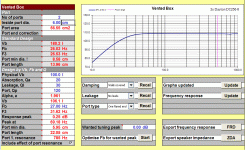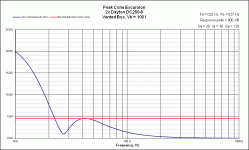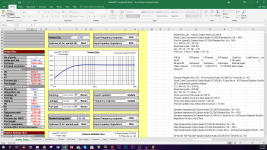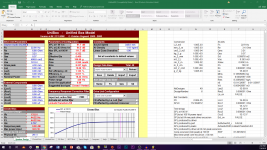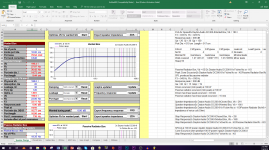Back to the 1st Unibox lesson. Choose any driver. Double click in the Name cell, enter the new name and parameters, etc, etc, and Save.
Save as well every time you finish working with any driver too.
Save as well every time you finish working with any driver too.
Ok I spent lots of time analyzing the 5 drivers that you linked.
The 250 had very similar graph results to the 315 but the Max SPL at 100w is about 2 dB below and I think this is a big difference but I may be wrong. (this is 110 to 112dB)
The other ones were also similar but the 315 has good xmax as well as a recommended box size that is close to by box goals. All the other ones had recommended box sizes that were hundreds off from my goals and I think that would make a difference.
If you think I should look at other graphs or change some inputs I will do so but in my judgement the DSA315-8 is still the main contender.
The 250 had very similar graph results to the 315 but the Max SPL at 100w is about 2 dB below and I think this is a big difference but I may be wrong. (this is 110 to 112dB)
The other ones were also similar but the 315 has good xmax as well as a recommended box size that is close to by box goals. All the other ones had recommended box sizes that were hundreds off from my goals and I think that would make a difference.
If you think I should look at other graphs or change some inputs I will do so but in my judgement the DSA315-8 is still the main contender.
Xmax isn't a design criteria, SPL is. The Peerless actually has the most at 8mm and the DA270 is next at 6mm anyways.
One or 2 dB difference is just barely discernible. In fact 3dB is considered the minimum change needed to be perceived as as something different, but I find that to be overstated. A difference of 10dB is needed to be perceived as twice or half as loud.
You might actually try to get a hold of an SPL meter or download one as an app and just try to get a reading of how loud you are currently playing your music at it's loudest. The results might surprise you.
Also remember, the Standard Design is just a suggestion. I found 4 of them will pretty much meet the design goals in about 120L-140L. Max SPL varies a little bit , with 1 of the 5 drivers not quite reaching the desired max SPL, but in my opinion, anything over 110dB @1m is just gravy.
Maybe try going over them again with fresh eyes tomorrow. You could even include the Dayton DS 10" and 12" too although the prices are pretty similar to the DSA line. I think that's why I didn't include them before, but I can't remember now.
One or 2 dB difference is just barely discernible. In fact 3dB is considered the minimum change needed to be perceived as as something different, but I find that to be overstated. A difference of 10dB is needed to be perceived as twice or half as loud.
You might actually try to get a hold of an SPL meter or download one as an app and just try to get a reading of how loud you are currently playing your music at it's loudest. The results might surprise you.
Also remember, the Standard Design is just a suggestion. I found 4 of them will pretty much meet the design goals in about 120L-140L. Max SPL varies a little bit , with 1 of the 5 drivers not quite reaching the desired max SPL, but in my opinion, anything over 110dB @1m is just gravy.
Maybe try going over them again with fresh eyes tomorrow. You could even include the Dayton DS 10" and 12" too although the prices are pretty similar to the DSA line. I think that's why I didn't include them before, but I can't remember now.
May be time has come to introduce again old proven practice
of linking tutorials universally accepted as a good start. Dave's "Simple Loudspeaker Design" for instance.
software
IMO, one should first master loudspeaker design in a virtual surrounding. Eminence range of speaker units is truly great for any beginner, good quality and affordable. Speaker driver datasheet, FP Graph Tracer to turn measured data into textual files needed for simulation programs, baffle edge diffraction designer, vented box designer, response modeler to manipulate frequency response and impedance as well, XSim crossover simulator, that's probably enough.
of linking tutorials universally accepted as a good start. Dave's "Simple Loudspeaker Design" for instance.
software
IMO, one should first master loudspeaker design in a virtual surrounding. Eminence range of speaker units is truly great for any beginner, good quality and affordable. Speaker driver datasheet, FP Graph Tracer to turn measured data into textual files needed for simulation programs, baffle edge diffraction designer, vented box designer, response modeler to manipulate frequency response and impedance as well, XSim crossover simulator, that's probably enough.
-Couldn't find a driver that just says "DS" they all have numbers next to the letters...
I understand my box design goals are up to me but I feel the program is recommending the volume of my box for a reason. The 2 12" drivers (DC300 and DSA315) Come closest to the "Vas" input however the "Stander Design" tab Vb is closest to my design goals on DSA315 and DC250. I know it is up to me but for the other drivers those are either way below or way higher so I think that means something.
I understand my box design goals are up to me but I feel the program is recommending the volume of my box for a reason. The 2 12" drivers (DC300 and DSA315) Come closest to the "Vas" input however the "Stander Design" tab Vb is closest to my design goals on DSA315 and DC250. I know it is up to me but for the other drivers those are either way below or way higher so I think that means something.
Thanks for that link Lojzek. I tried to reference Dave Dal Ferra's tutorial the other day but for some reason my old link was broken.
Yup, designing in the virtual realm is where we are at. I'm just starting with 1 thing at a time. Right now, it's box modeling and woofer selection. For a raw newcomer, my plans are to try to avoid measurements if we can. A kit would ensure that but that's not the way Will wants to go. So I'm keeping my fingers crossed that simulations will get us where we want to go.
Yup, designing in the virtual realm is where we are at. I'm just starting with 1 thing at a time. Right now, it's box modeling and woofer selection. For a raw newcomer, my plans are to try to avoid measurements if we can. A kit would ensure that but that's not the way Will wants to go. So I'm keeping my fingers crossed that simulations will get us where we want to go.
[URL="https://www.parts-express.com/dayton-audio-ds270-8-10-designer-series-woofer-speaker--295-432"]Dayton DS270-8[/URL]
Dayton DS315-8
A driver's parameters like Vas and xmax and sensitivity and Qms and the suggested "best" alignment all matter but how they work together and whether or not you can manipulate them into something that works for you is what's most important.
I think that the conclusions you've reached about those 5 drivers aren't quite the same as mine but I can't be 100% sure because you haven't shown me your work. (It's summer and you can't get away from someone who sounds like a teacher. Ahhhh!! 😱 Hope that's going to be ok.) For eg, I found the DC250-8 to be the only driver of the 5 that didn't meet the design criteria - 2 of them in 100L tuned to 27Hz will give you an F3 of about 32Hz but with 30W, max SPL is only 108dB before xmax gets exceeded. So that's a fail. Charts attached below.
I'm not sure what will work best for you here. Do you want to keep working with Unibox on those drivers or do you want me to post the results that I got? Which do you think you will learn more from?
Dayton DS315-8
A driver's parameters like Vas and xmax and sensitivity and Qms and the suggested "best" alignment all matter but how they work together and whether or not you can manipulate them into something that works for you is what's most important.
I think that the conclusions you've reached about those 5 drivers aren't quite the same as mine but I can't be 100% sure because you haven't shown me your work. (It's summer and you can't get away from someone who sounds like a teacher. Ahhhh!! 😱 Hope that's going to be ok.) For eg, I found the DC250-8 to be the only driver of the 5 that didn't meet the design criteria - 2 of them in 100L tuned to 27Hz will give you an F3 of about 32Hz but with 30W, max SPL is only 108dB before xmax gets exceeded. So that's a fail. Charts attached below.
I'm not sure what will work best for you here. Do you want to keep working with Unibox on those drivers or do you want me to post the results that I got? Which do you think you will learn more from?
Attachments
I think for the space have 160L is the best and that's what I've been putting in. This could be a factor in our different results.
After a quick scan of the last few pages(without my glasses) I didn't see you mention what "Port QP" is I have been putting it at 120 and this my be effecting our different results. Unibox says "Enclosure Q at F3 due to port friction losses) which I don't quite understand
Also I have no problem with you being like a teacher I am lucky to have a "teacher(s)" helping me with this project, don't know how I will repay!
I am lucky to have a "teacher(s)" helping me with this project, don't know how I will repay!
After a quick scan of the last few pages(without my glasses) I didn't see you mention what "Port QP" is I have been putting it at 120 and this my be effecting our different results. Unibox says "Enclosure Q at F3 due to port friction losses) which I don't quite understand
Also I have no problem with you being like a teacher
 I am lucky to have a "teacher(s)" helping me with this project, don't know how I will repay!
I am lucky to have a "teacher(s)" helping me with this project, don't know how I will repay!Unibox shows you the 5 factors that most affect a vented box: Vb, Fb (which changes port length), Qa, Ql and Qp. The last 3 are minor factors and are usually set with their little drop down menus and then forgotten about. With ports, you're mostly concerned with chuffing and with placement. Chufing is controlled mostly by port diameter which affects port velocity but it's also mitigated by flaring 1 or both ends. The typical diy method for ports is to buy some plumbing pipe, glue it onto your baffle and then use a router on the baffle opening to make the flare. So that will be the 'One flared end' setting. Don't worry about it after that.
There can actually be some complications in terms of port placement but let's not worry about that now other than the general rule of thumb is that the inside end of your port(s) should be at least a distance equal to the port diameter away from any cabinet walls. Also air movement in and out of the port should not be obstructed by any stuffing.
The primary variables that change a vented box response are box volume and port length (by changing Fb). So setting Vb to 160L all the time with these drivers is not the right approach. The point is to change either the size of the box or the box tuning or both until you get the response you want or until you prove that it can't be done with that driver and therefore discard it from consideration.
So I think what we should do next is take this 1 driver at a time. Let's try the Dayton DC300-8 next. Do exactly what I just did above with the DC250-8. Do the best job you can with it to meet your goals and then attach a pic of the vented box section like you have done before and let me also know how much power you have used to reach its max SPL.
Let's see how that goes.
There can actually be some complications in terms of port placement but let's not worry about that now other than the general rule of thumb is that the inside end of your port(s) should be at least a distance equal to the port diameter away from any cabinet walls. Also air movement in and out of the port should not be obstructed by any stuffing.
The primary variables that change a vented box response are box volume and port length (by changing Fb). So setting Vb to 160L all the time with these drivers is not the right approach. The point is to change either the size of the box or the box tuning or both until you get the response you want or until you prove that it can't be done with that driver and therefore discard it from consideration.
So I think what we should do next is take this 1 driver at a time. Let's try the Dayton DC300-8 next. Do exactly what I just did above with the DC250-8. Do the best job you can with it to meet your goals and then attach a pic of the vented box section like you have done before and let me also know how much power you have used to reach its max SPL.
Let's see how that goes.
btw with an app on my phone, the current max volume that I play on my JBLs seem to be between 100 - 105dB. A change to 110dB doesn't seem that big...
Oh god, your poor ears. If the app is actually accurate, I'm the one that's surprised. I did not expect it to be that loud.
I still wouldn't change the max SPL criteria of 110dB though. That's twice as loud as 100dB. And exposing yourself repeatedly to just 100dB for short periods of time can permanently damage your hearing. That's not something that you really think about at 14 but believe me, it can seriously screw you up later in life.
I still wouldn't change the max SPL criteria of 110dB though. That's twice as loud as 100dB. And exposing yourself repeatedly to just 100dB for short periods of time can permanently damage your hearing. That's not something that you really think about at 14 but believe me, it can seriously screw you up later in life.
haha it turns out that app was just way off, I tried a different app and said that the music was ~80dB. I have a future of music production and rely on music all the time and have
already killed many nerves in my ears but I will try to avoid going past 100dB with my DIY speakers. I think earbuds are more of a threat than speakers though.
already killed many nerves in my ears but I will try to avoid going past 100dB with my DIY speakers. I think earbuds are more of a threat than speakers though.
Now that sounds more like it. Most loud listening is up around 85db-90dB. Very loud is when you start going above that. It would be wise indeed if you plan on using your ears for your career to take good care of them.
And it looks like you've got some rather thin, thin speaker wire there with very high resistance. 😉
For the purposes of comparison, in the 'External Components' section, I just leave Rs at 0. Unless you are running very long lengths of speaker wire, or very, very thin or maybe made of some pretty resistive material, Rs is at most going to be .1 or .2ohm.
Makes for a fairly large difference though.
Set it to 0 and let's try again.
For the purposes of comparison, in the 'External Components' section, I just leave Rs at 0. Unless you are running very long lengths of speaker wire, or very, very thin or maybe made of some pretty resistive material, Rs is at most going to be .1 or .2ohm.
Makes for a fairly large difference though.
Set it to 0 and let's try again.
- Status
- Not open for further replies.
- Home
- Loudspeakers
- Multi-Way
- Questions about speaker building
